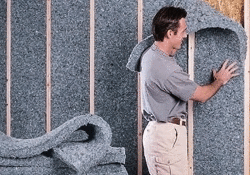WALL PAPERS AND BORDERS IN WALL DECORATION

Lift a corner of wallpaper in many homes and a decorative history unfolds, layer upon layer. Adding pattern to plain walls is a decorative device that has an age-old pedigree. Wallpaper was first introduced as a substitute for tapestry wall hangings. Later it was used to compensate for the lack of architectural features such as a cornice or frieze, and eventually columns and garlands mingled in designs which made wallpaper a unique decorative link between textiles and architecture. Nowhere is wallpaper's role as a substitute more valuable than in the hallways and workrooms of a house. Tile-patterned wallpaper suitable for kitchens dates from the eighteenth- century when it was used as a replacement for Delft tiles - the real thing. Architectural borders have a similar pedigree and are invaluable today when so many homes have been stripped of ornament. Carefully shaded to create perspective, egg and dart, den tilled or Greek key borders will compensate for a missing cornice, while deep borders or friezes, purpose-made or cut from lengths of random-design wallpaper, fill the gap between cornice and picture rail. And lower down, wallpapers or high-relief panels provide a practical dado. For a decorative effect, use garlands and ribbon design borders to surround a mirror or window, to define a skirting board or to accentuate a picture rail. Choice of paper As walls present the largest area in a room, it is wise to choose wallpaper with care. Subtle designs are often best for living rooms, where the impact of a distinctive design may soon wane. Damask effects in rich colours suit a traditional sitting room with more formal furnishings. For a lighter look, consider a sprig or abstract design taken from the background of a fabric print. The soft, overall pattern creates a hazy, broken-colour effect on the walls and can co-ordinate with curtains where it is given emphasis by the addition of a more dominant motif. Stripes are always elegant in a living room setting. You may need to break the rules when hanging striped and geometric designs. They should be hung to appear straight to the eye, not the plumb line, and any discrepancies can usually be tucked out of sight in an alcove or by a door. If the walls are obviously out of true, add a picture or dado rail to provide a practical frame. Rich hues like jade green or plum on a paler ground create a soothing backdrop, while ivory and cream let in the light and are more subtle than white. As you search for compatible colours and styles, look to the past for inspiration. Remember that time has bleached period furnishings and affected our perception of earlier styles. Before they faded, many wallpapers were surprisingly bright. The eighteenth century had a penchant for yellow, chocolate brown and verditure (blue- grey) wallpapers as well as the soft sage green often associated with the period. Horace Walpole's house at Strawberry Hill featured no fewer than seven designs of wall pa per and border, all in different colours, and 'the room where we always live' was decorated with a 'blue and white paper adorned with festoons ... and luxurious settees covered with linen of the same pattern' - an early example of co-ordinated furnishings. Victorian wallpapers were darker, densely patterned with trefoil or paisley shapes in deep burgundy and forest green, which suited the heavier style of decoration and, more practically, disguised the results of pollution caused by smoke and smog.